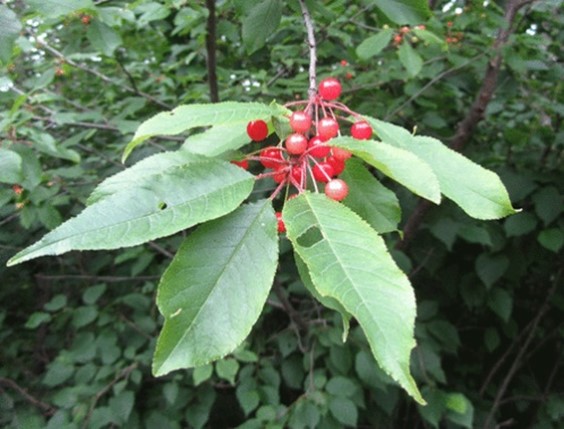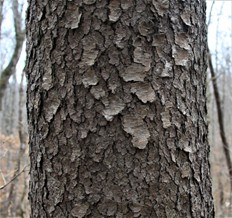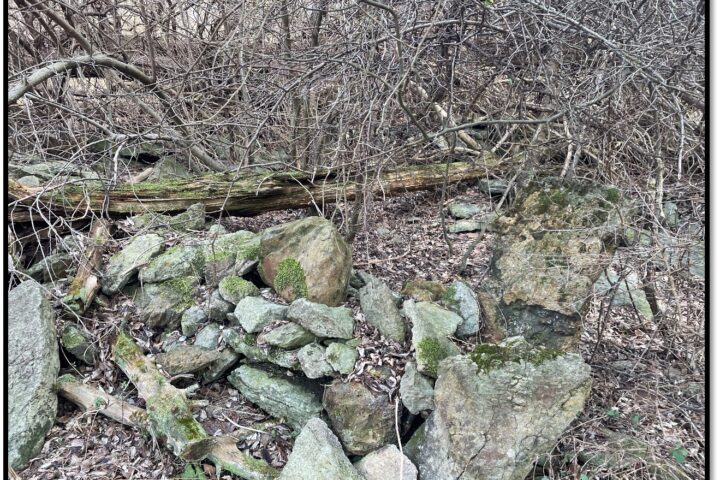
by John Schwartzer
There is a point in the summer when every roadside farm stand is overflowing with fruits. Peaches, apricots, plums, sweet and sour cherries, displayed in little cardboard boxes and arranged in neat rows, entice fruit lovers. Those boxes overflowing with summer bounty give no testimony to the fact that most of these fruits are not native to the area.

Pennsylvania abounds with native fruits that are just as tasty and nutritious as their Asian, Middle Eastern, and European analogs. In the cherry group alone, we have four native species. Cherries belong to the rose family and are species of the Prunus genus, which all have five-parted flowers. The fruits are fleshy drupes, meaning they contain one hard seed. All cherry leaves have one blade to each stem.
There is usually a small bump or two at the base of each leaf blade or along the leaf stem. These glands, known as extrafloral nectaries, exude nectar to attract beneficial insects, like ants. The ants then protect the plant from insect herbivores.

Extrafloral nectaries on black cherry leaf
Cherries provide fruit that are eaten by box turtles, numerous birds, and mammals, including foxes, bears, raccoons, opossums, deer, rabbits, squirrels, humans, and various rodents.
Below the genus level the classification gets a little more complicated. Prunus found in Pennsylvania are divided into three subgenera, but botanists are still figuring out the details. New genetic studies are changing our understanding of the relationships within the Prunus genus.

Sand Cherry

Choke Cherry
Sand cherries are the largest fruited native cherries (sometimes called plums) and one of the smallest native Prunus plants. These diminutive shrubs grow in southeastern PA in association with lowbush blueberries and sweetfern. The fruits are acidic and occasionally bitter.
As the name exaggerates, the fruits of chokecherry are astringent, but perfectly edible. They can be used in preserves, syrups, and jellies. The hanging racemes of flowers are showy and makes this a nice yard tree, growing up to 30 feet.
Pin cherry (Prunus pensylvanica)


This small tree grows in disturbed sites from long lived seeds stored in the soil, which gives it another common name, the fire cherry. Seeds can germinate after 150 years of waiting. The fruit is bright red when ripe and very sour. The foliage is preferred browse for deer.
Black cherry (Prunus serotina)


More than 450 species of moths and butterflies feed on black cherry leaves. After black cherry seeds passed through a box turtle, they were found to have higher germination rates (Braun and Brooks, 1987). The fruits can be used to make jellies, wines, and to flavor alcoholic beverages. Look up “cherry bounce” for recipe inspiration.
For more information, check out these sources:
- Braun, J., & Brooks, G. R. (1987). Box Turtles (Terrapene carolina) as Potential Agents for Seed Dispersal. The American Midland Naturalist, 117(2), 312–318. https://doi.org/10.2307/2425973
- Guide to Sand Cherry (Prunus pumila): Harvesting and Cooking – (foragerchef.com)
- Prunus pensylvanica L (usda.gov)
- Paul Wray, Iowa State University, Bugwood.org
Photo Credits/Sources:
Melissa Askew, unsplash.com; Rob Routledge and Brett Marshall, Sault College, Bugwood.org; Homer Edward Price, flickr.com; biopix.com; Wikimedia Commons




